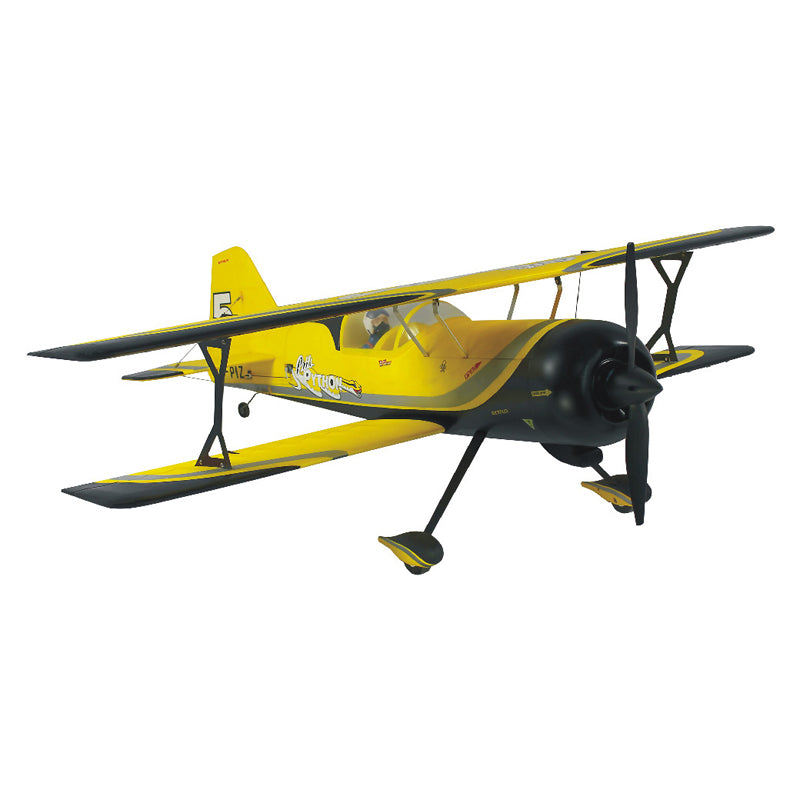
One of the most thrilling and visually impressive maneuvers in the world of RC aviation is the loop. This fundamental aerobatic move involves flying your RC plane in a vertical circle, pulling the aircraft up into a climb, continuing it through a 360-degree turn, and then gently bringing it back to level flight. In this article, I will guide you through the steps of performing a loop maneuver with an RC airplane, focusing on the Dynam Pitts Python Model 12 Yellow 4S RC Aerobatic 3D Sport Biplane as an example. Along the way, I’ll provide insights into the plane’s history, performance, and features, as well as share my personal experience flying this outstanding biplane.

Before diving into the specifics of performing a loop with an RC airplane, let’s first define what a loop maneuver is and why it’s so popular in aerobatic flying.
A loop is a basic aerobatic maneuver in which an airplane flies in a vertical circle. The pilot pulls the airplane up into a climb, and as the plane reaches the top of the climb, it completes the 360-degree turn, and the aircraft returns to its original flight path. The loop is usually performed at a moderate speed to ensure enough lift is generated to maintain control through the vertical portion of the maneuver.
For RC pilots, mastering the loop is a critical step in progressing to more complex aerobatics, such as the Immelmann turn or the barrel roll. It’s also a fun way to showcase your aircraft’s capabilities and your control skills.
The Dynam Pitts Python Model 12 is a high-performance 3d rc aircraft biplane that excels in a wide range of aerobatic maneuvers, including the loop. Its design, power, and control surfaces make it the ideal aircraft for both novice and expert pilots looking to master aerobatics.
The Pitts Python is a modern interpretation of the iconic Pitts Special, a series of biplanes originally designed for aerobatic competition. The original Pitts aircraft, developed in the 1940s and 1950s by Curtis Pitts, became a legend in the aerobatic world, known for its extreme agility and impressive roll rates.
Dynam’s version of the Pitts Python brings this legacy to the RC world with a lightweight yet durable design. The model features a 4S battery system, offering excellent power-to-weight ratio, and it is designed for 3D flight and precision aerobatics.
Having flown the Dynam Pitts Python Model 12 Yellow 4S RC Aerobatic 3D Sport Biplane, I can confidently say that it’s one of the most rewarding RC planes for mastering aerobatics. The combination of power, precision, and durability makes this plane an ideal choice for performing loops.
When I first attempted a loop with this biplane, I was amazed at how smoothly it executed the maneuver. The plane climbs effortlessly and performs a crisp, tight loop with little effort on my part. The responsive controls allowed me to adjust the plane’s angle and speed mid-maneuver, ensuring that I could complete the loop smoothly without losing control.
Now that we understand the plane we’re working with, let’s go through the step-by-step process of performing a loop with your RC airplane. The Dynam Pitts Python is an excellent plane for this, but the following steps apply to most aerobatic planes.
Before attempting a loop, ensure your plane is set up for aerobatic flying:
For a successful loop, you need both altitude and speed:
To begin the loop:
Once your plane is at the top of the loop, the aircraft will be inverted. At this point:
While the Dynam Pitts Python makes the loop maneuver easier with its excellent design, here are some tips to help you perfect the loop:
One common mistake when performing loops is pulling back too hard on the elevator. This can cause the plane to climb too steeply and stall. Instead, pull gradually and steadily to maintain control throughout the maneuver.
Keep the throttle steady throughout the loop. Sudden increases or decreases can cause the plane to lose control, especially at the top of the loop. A steady throttle ensures smooth transitions throughout the maneuver.
Once you’re comfortable with the loop, practice at different speeds. Slower loops will require more precise control inputs, while faster loops will test your plane’s stability.
For the Pitts Python, aim for a moderate to high speed. Too slow, and the plane may stall; too fast, and you might risk over-stretching the loop. A smooth, steady speed works best.
Yes, smaller planes can perform loops, but they might require more precise control, especially during the vertical portions. Larger planes like the Pitts Python are generally more stable during aerobatic maneuvers.
If your plane stalls, gently push the nose down and apply throttle. In most cases, the Pitts Python’s power system will help you recover quickly, but always maintain a gentle pull on the elevator.
The loop is a classic aerobatic maneuver that every RC pilot should master, and the Dynam Pitts Python Model 12 Yellow 4S RC Aerobatic 3D Sport Biplane is an excellent aircraft for performing this maneuver. With its powerful 4S system, agile design, and responsive control surfaces, the Pitts Python ensures a smooth, impressive loop every time. By following the steps outlined in this guide, practicing regularly, and applying the tips provided, you’ll be well on your way to mastering the loop and adding an exciting skill to your RC flying repertoire.